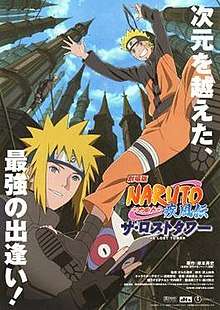Naruto Shippuden the Movie: The Lost Tower
| Naruto Shippuden the Movie: The Lost Tower | |
|---|---|
 Japanese film poster | |
| Directed by | Masahiko Murata |
| Produced by |
Fukashi Azuma Naoji Hōnokidani |
| Written by | Junki Takegami |
| Starring | |
| Music by | Yasuharu Takanashi |
Production company | |
| Distributed by | Toho |
Release date |
|
Running time | 85 minutes |
| Country | Japan |
| Language | Japanese |
| Box office |
¥1.03 billion (US$8.5 million) |
Naruto Shippuden the Movie: The Lost Tower (劇場版 Naruto-ナルト-疾風伝 ザ・ロストタワー Gekijōban Naruto Shippūden: Za Rosuto Tawā) is a 2010 Japanese animated film based on Masashi Kishimoto's manga and anime series. It was released on July 31, 2010.[1] Along with the film, a comical short feature named Naruto, the Genie, and the Three Wishes!! (劇場版NARUTO-ナルト-そよ風伝 ナルトと魔神と3つのお願いだってばよ!! Gekijōban Naruto Soyokazeden: Naruto to mashin to mitsu no onegai dattebayo!!) was also shown. The theme song "if" is performed by Kana Nishino. The film was released in North America on September 17, 2013 by Viz Media.
Plot
Assigning on a mission to capture a missing-nin named Mukade, Naruto Uzumaki, Sakura Haruno, Yamato and Sai wield chakra-knives. At the one thousand year old city ruins of Rouran, they confront Mukade, a time traveller attempting to dominate the Ninja World with the power of the Ryūmyaku (the Ley Line in English), an ancient chakra flowing deep underground. He breaks Minato Namikaze's seal to unleash the power, causing the light to engulf Naruto and Yamato, before Sai and Sakura ride on an ink bird and attempt to escape.
Naruto and Yamato are sent twenty years into the past. When Naruto awakens from this time slip, he meets the queen of Rouran Sāra. It is later revealed that Mukade traveled to the past six years and changed his name to Anrokuzan, the minister of Loran who killed Sāra's mother Sēramu. Naruto agrees to protect Sāra, after Anrokuzan declares about the kidnapped citizens and creates to summon the "Puppet Ninja Forces". Minato, Shibi Aburame, Chōza Akimichi and Kakashi Hatake appear to support the heroes. While they rescue Sara's people and Naruto holds Minato's kunai, Sāra recalls her memory about Sēramu's lullaby. Anrokuzan uses the parts of the tower to become a giant defensive puppet. Minato and Naruto use their regenerative chakra enough to create the legendary Super Rasengan. After Sāra disables Anrokuzan's technique, Minato exposes Anrokuzan's weak spot and Naruto destroys it. As Yamato and Kakashi rescue Naruto and Sāra, Minato uses the kunai to completely seal off the power. Just as the heroes vanish from the past, Minato asks Naruto not to change history by erasing all of their memories.
With Mukade gone, Sakura and Sai reunite with Naruto and Yamato. As they are about to leave the ruins, they run into Queen Sāra's daughter, who kept the old chakra blade that belonged to Naruto. She informs that it was given to her mother by a 'hero in a dream'. Naruto recognises his blade, reaches out to his back where he usually keeps his blade but it isn't there. He's left dumbfounded.
Cast
| Character | Japanese Voice Actor | English Voice Actor |
|---|---|---|
| Naruto Uzumaki | Junko Takeuchi | Maile Flanagan |
| Sakura Haruno | Chie Nakamura | Kate Higgins |
| Yamato | Rikiya Koyama | Troy Baker |
| Sai | Satoshi Hino | Ben Diskin |
| Minato Namikaze | Toshiyuki Morikawa | Tony Oliver |
| Young Kakashi | Mutsumi Tamura | Dave Wittenberg |
| Young Guy | Mayuki Makiguchi | Ben Diskin |
| Young Asuma | Fujiko Takimoto | Doug Erholtz |
| Third Hokage | Hidekatsu Shibata | Steve Kramer |
| Tsunade | Masako Katsuki | Debi Mae West |
| Shizune | Keiko Nemoto | Megan Hollingshead |
| Jiraiya | Hōchū Ōtsuka | David Lodge |
| Shibi Aburame | Kenji Hamada | Crispin Freeman |
| Chōza Akimichi | Nobuaki Fukuda | Michael Sorich |
| Sāra | Saori Hayami | Eden Riegel |
| Sēramu | Yumi Tōma | Mary Elizabeth McGlynn |
| Mukade / Anrokuzan | Ryūzaburō Ōtomo | JB Blanc |
| Masako | Yuko Kobayashi | Laura Bailey |
| Sarai | Fujiko Takimoto | Lucien Dodge |
Home media
The film was released on DVD on April 27, 2011.
References
- ↑ "西野カナ、新曲は劇場版「Naruto」主題歌" [Kana Nishino's New Song Is the Theme of the Film Naruto]. Oricon Style (in Japanese). Oricon. June 15, 2010. Retrieved June 19, 2010.